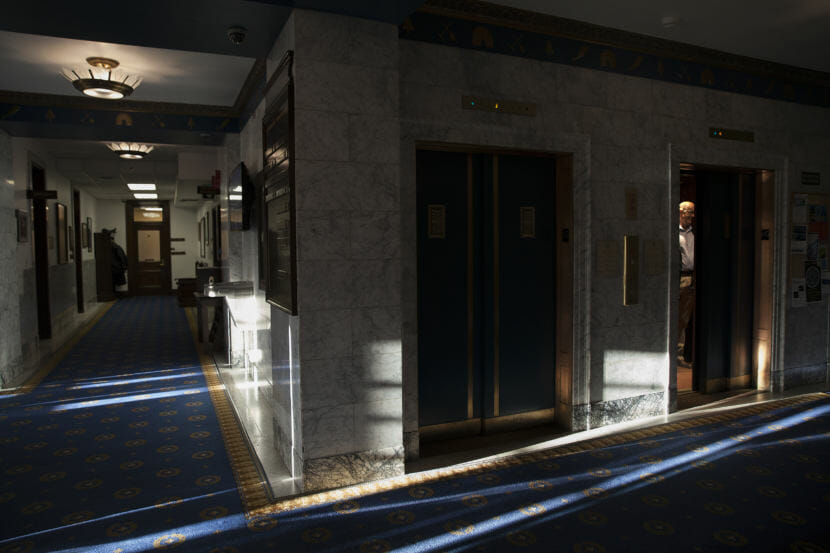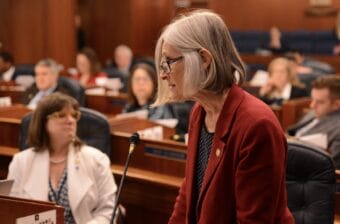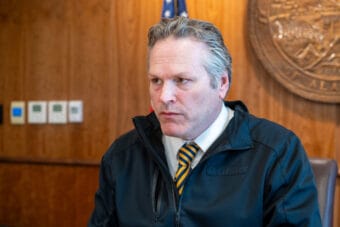
Most members of the Alaska House minority disappeared from the state Capitol in a dispute over tying increased education funding to spending from the state’s savings account.
They returned later, but that surprise came as the House tried to hash out a state budget that, for now, still includes a huge gap between revenue and proposed spending and big questions about how to pay for state services, as well as this year’s Permanent Fund dividend.
Alaska Beacon reporter James Brooks has been covering the Legislature for about a decade and says Wednesday was one of the weirdest days at the Capitol that he’s ever seen.
Listen:
Editor’s note: This interview was recorded before members of the House minority returned to the chamber.
The following transcript has been lightly edited for clarity.
James Brooks: Basically, members of the House minority — a group of Democrats, independents, and one Republican — walked out of the state House and have effectively vanished. And they did that in order to avoid a vote on a controversial amendment to an amendment dealing with public school funding. Basically, what the amendment would do is tie a vote on spending for public schools to a separate vote on spending from a state savings account to cover a projected budget deficit.
Casey Grove: It is Juneau, and it seems like it’d be hard to flee the state Capitol as it is, just geographically.
James Brooks: Well, I’ve been looking at ferry schedules and talking to people at the airport and even just walking around downtown Juneau to see, “Hey, are there any legislators on the other side of that window?” But I haven’t found anything. And as far as I can tell, the House majority hasn’t found anything, either.
Casey Grove: So remind us how we got here. There was some news yesterday about some temporary education funding, at least being approved in that process. What was that?
James Brooks: Yeah, we got here because when the budget hit the House floor on Monday, there was a projected deficit of about $418 million for the 12 months that start July 1. That’s the budget we’re talking about here. And lawmakers inserted another $175 million in temporary aid to K through 12 public schools. If you distribute that according to the state’s per-student funding formula that works out to just under $50 million for Anchorage, over $24 million for the Mat-Su, and smaller amounts for other school districts. Those districts have been asking for funding increases, saying that inflation has really hit their budgets hard, forced them to cut programs, cut staff, and resulted in poor education for public school students.
So when that amendment passed, it increased the deficit to a little under $600 million. The state’s primary savings account, the Constitutional Budget Reserve, would be used to pay for that deficit. And that’s what today’s argument was about. Members of the minority didn’t want to be forced to vote for this funding from savings in order to get the education funding that they support.
Casey Grove: Where would that money come from, though, to cover the deficit, if not from the CBR?
James Brooks: There is not an easy option. Except — and this isn’t all that easy — except overspending from the Permanent Fund. Because each year there is a limit on the amount of money that’s transferred from the Permanent Fund to the state treasury, specifically, to prevent situations like this, where lawmakers might be pressured to spend beyond what’s sustainable from the Permanent Fund.
Casey Grove: Right. And I guess I can see how differing ideologies might be at play here. And of course, I mean, we’ve kind of been in a similar situation in the past, with the Permanent Fund Dividend. So I should ask, where is the Legislature at with setting an amount for the PFD? And how does that factor into this larger budget discussion?
James Brooks: Right, and that’s what the members of the minority have suggested is their preferred solution, is to reduce the Permanent Fund dividend from $2,700 per recipient, down to about $1,300, $1,350 per recipient. That takes care of your deficit, but at the same time, it’s not the preferred option for all legislators, because higher dividends are preferred by voters.



